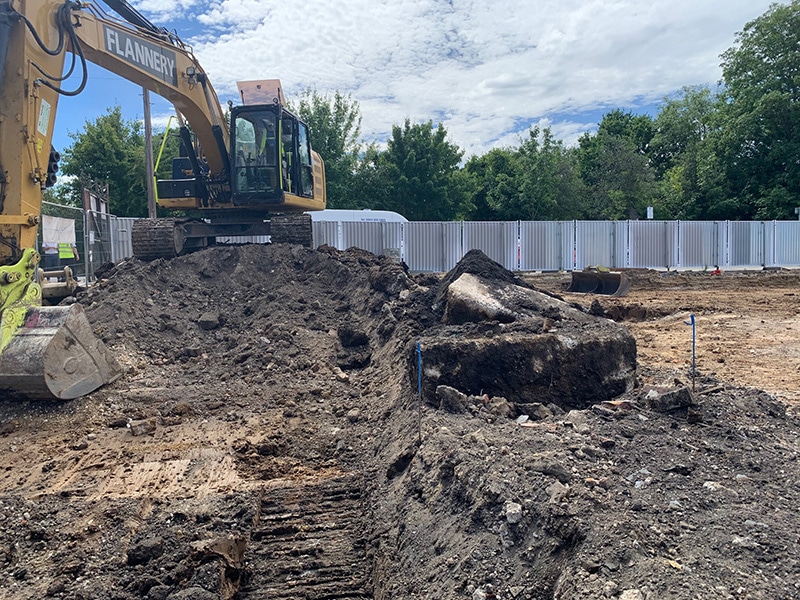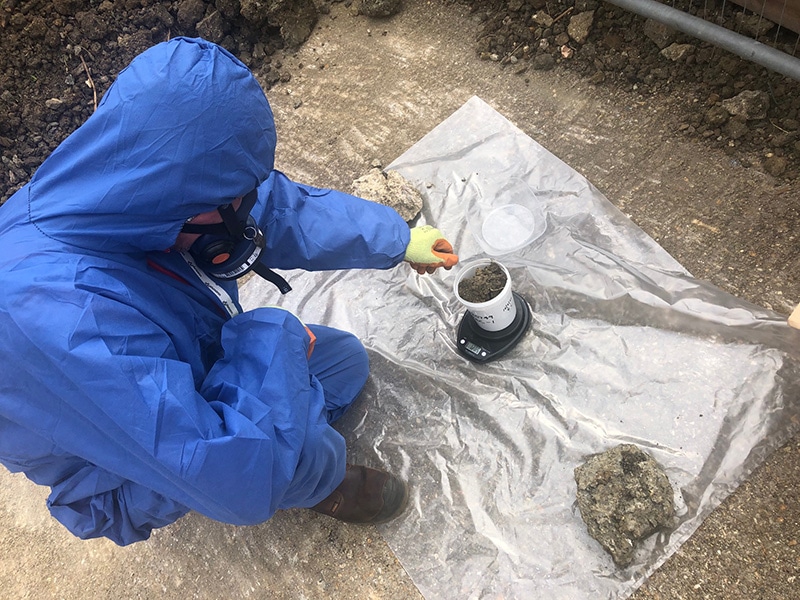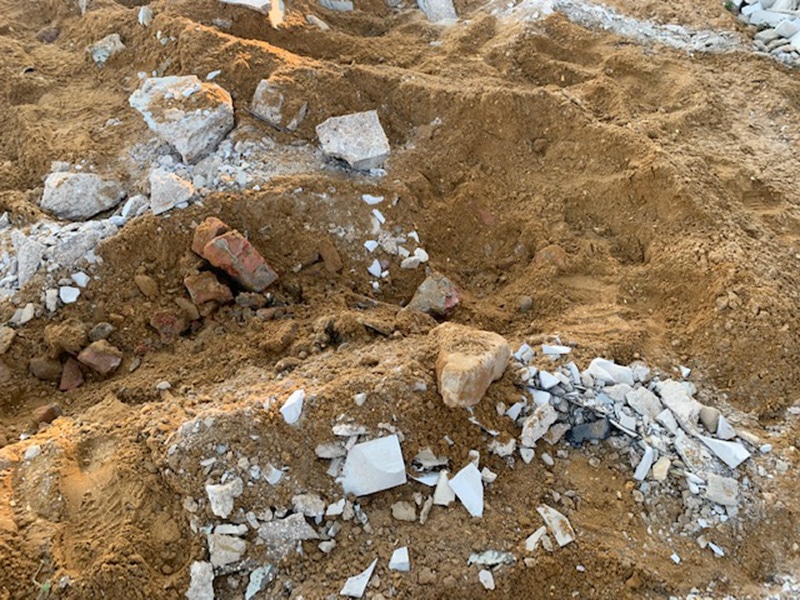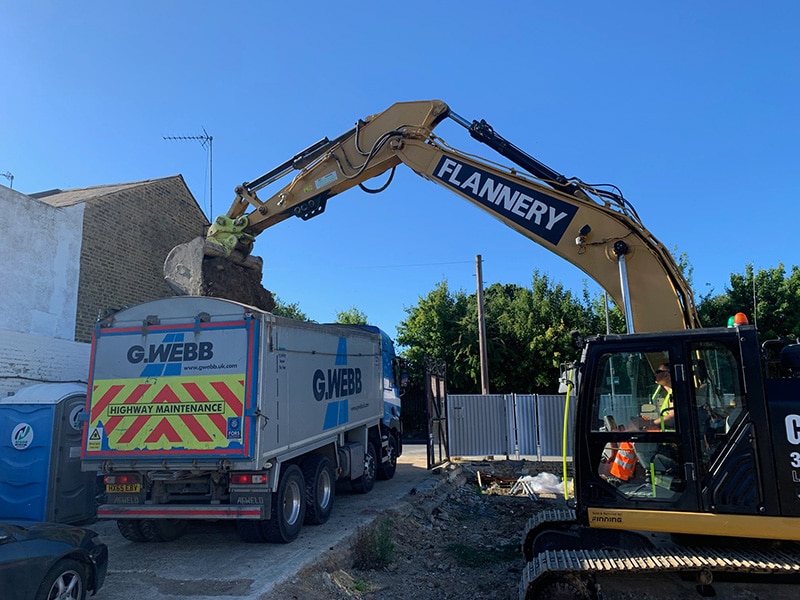Guide to Working with Asbestos Contaminated Land, Soil and Construction Waste
Brownfield sites containing asbestos can be challenging. If you want to avoid unnecessary delays, expense and hidden surprises, it’s important that you plan correctly to minimise the risks associated with asbestos-contaminated land, soil and construction waste.
When it comes to brownfield sites, the most common works to be undertaken are excavation and landscaping works prior to the construction of new structures. It is very common on brownfield sites to uncover previous waste, materials, and other items containing asbestos materials. These asbestos materials are generally leftover from historical demolition and associated construction works previously undertaken at the site.
Historically demolition and construction works were undertaken poorly in comparison to today’s standards. In the past, it was common during demolition and construction works for waste from these works to be buried in or spread across sites. It was also common for such buried and spread waste to contain large quantities of asbestos. In short, this gives rise to asbestos-contaminated land, soil and construction waste.
It is essential that if you are working on a site classed as a brownfield or unknown site, you consider all of the risks and potential challenges you may face should the land, soil, or waste at the site be asbestos-contaminated.
What types of asbestos am I likely to find on contaminated land and in soil?
As asbestos contamination to land, soil or construction waste is likely to be from historical demolition and construction work, then every type of asbestos material that can be found within the general construction of a building may be discovered. Generally, asbestos materials are divided into two categories: licensed asbestos materials and non-licensed asbestos materials. Although not exhaustive, the following list includes the main asbestos materials you may find on or in asbestos-contaminated land, soil or waste. However, there are over 3000 types of construction materials that are known to have contained asbestos:
Common licensed asbestos materials to asbestos-contaminated land, soil or waste:
- Asbestos insulating board
- Asbestos millboard
- Asbestos thermal insulation
- Asbestos sprayed insulation
Common non-Licensed asbestos materials to asbestos-contaminated land, soil or waste:
- Asbestos cement
- Asbestos textured coating
- Asbestos vinyl floor tiles
- Asbestos bitumen
- Asbestos ropes and textiles
- Asbestos paper, felt and cardboard
The big challenge in identifying asbestos contamination to land, soil and waste is the condition that the asbestos material may be in. Although, on many occasions, asbestos land contamination is with large sections of relatively whole sections of asbestos materials, it is usual for such materials to be highly damaged, broken and in very small fragments.
Dependent upon how long the asbestos contamination to the land has been left for, further degradation of the asbestos materials will have occurred. This results in the asbestos contamination being in the form of unbonded asbestos fibres.
Although the larger sections of asbestos material can be observed with the naked eye, it is common for asbestos-contaminated land, soil and waste to have substantial asbestos contamination in the form of non-visible asbestos fibres and fibre bundles. This is where adequate testing of the suspected asbestos contaminated land and soil must be carried out. The investigation must include an asbestos-contaminated land survey, asbestos bulk sampling and asbestos in soil testing.
What are the risks of asbestos-contaminated land, soil or waste?
Asbestos health risks are well known. The question is, are the risks of asbestos-contaminated, land soil or waste the same as those where asbestos is located within the structure of a building?
As asbestos on or in contaminated land and soil are more likely to be damaged, fragmented and fibrous, the risks are greater. This is due to the increased likelihood of asbestos fibres being released into the air due to damage and degradation. Asbestos in buildings is likely to be in a better condition, allowing for controlled treatment, thus preventing asbestos fibre release and subsequent inhalation and asbestos exposure.
If asbestos-contaminated land, soil or waste is not identified and treated correctly, then the usage of heavy machinery for excavation and land works has a high potential to create airborne asbestos fibre concentration. This can then result in heavy exposure and subsequent asbestos related health issues. This poses a risk to those directly involved in the work on the asbestos-contaminated land, soil or waste, and those who visit the site or in the area.
How should the risks from asbestos-contaminated land, soil or waste be managed and by whom?
When considering working with asbestos, the main document which must be applied and complied with is the Control of Asbestos Regulations 2012.
As asbestos on or in contaminated land, soil or waste is not fully explained within the current asbestos regulations, the group CL:AIRE (a group for all those involved in sustainable land reuse) in partnership with the Health & Safety Executive and industry contractors, have released a guide called CAR-SOIL. This document explains in detail how to assess and manage the risks from asbestos-contaminated land, soil and waste.
All those involved in any project where there is a potential of asbestos-contaminated land and waste must ensure that they follow the guidance laid out in these documents or potentially face prosecution from the Health and Safety Executive. Those with the primary responsibility of assessing and controlling these risks are those who employ contractors, sub-contractors and anyone else that is likely to disturb asbestos on or in land and soil. If you are unsure, you must employ an asbestos consultant with the expertise to enable you to comply with the law. For further information, contact a member of the team at Oracle Solutions.
What should I do if I have asbestos-contaminated land, soil or waste?
The following is not an exhaustive list and each site or case of asbestos-contaminated land, soil and waste is different. However, as a guide, you should have or at least consider the following to ensure legal compliance and avoid asbestos exposure or prosecution:
An asbestos-contaminated land survey. This will detail the presence of asbestos-containing materials at the site and outline the types of asbestos, how much there is and where it is likely to be distributed. The survey will include any areas in which you have planned excavation or groundworks. If required, the survey will include trial pits and inspection to required depths. The survey will also include asbestos bulk sampling and asbestos in soil sampling/analysis.
An asbestos-contaminated land risk management plan. This will include your proposed works and will detail how the asbestos contamination to the land, soil or waste will be dealt with to reduce the risk as low as is reasonably practicable. This plan will usually include the process you will be using to remove the asbestos contamination. It will include specific plans of work, personnel, and control measures to be implemented. Control measures will consist of dust suppression, access control and demarcating asbestos contamination risk zones. The plan will also have an emergency procedure for potentially uncovering additional asbestos contamination to the land or soil.
An asbestos consultant/contractor. This will ensure you have the expertise on hand to ensure regulatory compliance. Asbestos contractors must be fully HSE licensed for asbestos work where required. The asbestos consultant and licensed contractor will provide a full and detailed watching brief for the whole project, enabling all asbestos-contaminated land, soil, or waste to be safely and correctly dealt with. In addition, the asbestos consultant or contractor can effectively remove the asbestos-contaminated soil or waste to allow your project to proceed.
Specific Asbestos Training for Employees. All workers at the site must legally have appropriate asbestos training (asbestos awareness training) if there is even a very small likelihood that they may come across and disturb asbestos-containing materials while carrying out their roles. The training will include the correct provision of any required hygiene facilities, respiratory protective equipment, and personal protective equipment.
Ongoing Asbestos Testing and Asbestos Air Testing. During the project, it is essential to have ongoing asbestos bulk sampling and asbestos in soils sampling/analysis to confirm the location and extent of asbestos contamination as the project progresses. Asbestos air monitoring may be required throughout the project to confirm the effectiveness of all control and risk reduction measures. In addition, should asbestos-contaminated soil be removed from site, WAC (Waste Acceptance Criteria) testing may legally be required.
Asbestos Contaminated Land Project Record. There will be a large amount of information that must be gathered and retained during all works on the asbestos-contaminated land, soil or waste. The records will include asbestos-contaminated land surveys, asbestos bulk sampling, asbestos in soil sampling/analysis, asbestos air monitoring, asbestos soil waste disposal notes and all risk assessments/planning documentation. All these documents must be recorded and kept for a minimum period of 40 years in line with the asbestos regulations.
Oracle solutions provide all the above services and more. For asbestos-contaminated land, soil or waste services, contact a member of the team for more information.
How do I dispose of asbestos-contaminated soil or waste?
If you plan to remove the asbestos-contaminated soil or waste from the site fully, it will be dependent upon the project you are looking to undertake. In some circumstances, developers opt to reuse or retain an element of the asbestos-contaminated soil or waste.
This must be agreed upon and be in line with the enforcing authorities’ requirements, such as the Environment Agency, and be in strict accordance with the asbestos regulations. Generally, for asbestos-contaminated soil or waste to be retained, it must be placed within an area where it will be safe and manageable for the long term. This is usually beneath a covered area such as footings or similar. Wherever this occurs, the site records must show where the asbestos remains, what type of asbestos it is, and the extent. Retained asbestos-contaminated soil or waste must be managed year on year while it remains. This does not suit all asbestos contamination types and does not always suit the developer depending on the site’s long-term goals.
Many developers faced with asbestos-contaminated land, soil or waste, their preference, and what suits the project are to have all asbestos contamination removed. Where this is the case, soil and waste must be safely transported from the site and be disposed of at an asbestos landfill site in accordance with the relevant waste regulations.
Do I need to tell the HSE about my asbestos-contaminated land, soil or waste?
Health and Safety Executive involvement in asbestos-contaminated land, soil or waste will be dependent upon the site being worked on and the asbestos identified. Your asbestos consultant/contractor will advise you of this during the planning and project phases. Where asbestos contamination of soil or waste is considered licensed and all work associated with it is a licensed activity, you must engage a fully licensed asbestos contractor. The license holder will inform the HSE of works to be undertaken. This is a statutory notification of 14 days and is required by law.
In addition to the HSE, you must ensure that you are fully compliant with the brownfield site development’s local authority planning conditions.
How is the asbestos contamination to my land, soil or waste removed?
Removal of asbestos-contaminated land, soil, or waste depends on the specifics of the project being planned at the site. Generally, there are two options that the majority of asbestos-contaminated land, soil or waste sites have. However, some sites opt for a mixture of both options.
Asbestos Contaminated Land Removal Option 1:
Where the asbestos-contaminated land survey and testing have only identified asbestos to the site’s surface, and asbestos is in larger visible fragments, then the asbestos litter picking method can be the preferred option. This is where the site is divided into manageable sections. The asbestos contractor litter picks asbestos debris by hand, placing collected asbestos materials into suitable asbestos waste sacks ready for disposal. This can be a long and difficult task. However, it may be a more financially viable option for some sites. All surface asbestos litter picks must be undertaken in strict accordance with relevant asbestos legislation ensuring adequate control measures are in place for the removal and disposal process.
Asbestos Contaminated Land Removal Option 2:
Where asbestos contamination to the soil or waste is located beneath the surface, requires excavation, is fragmented significantly or is in a fibrous form. There is only one real choice for asbestos contamination removal. That is the full removal of the soil and waste, then transportation to a licensed asbestos landfill site for disposal.
This method requires strict control measures and must be completed in accordance with the asbestos regulations. The general approach is to remove soil and waste in bulk with a suitable heavy duty machine and then place the asbestos-contaminated soil or waste into a suitable HGV on site ready for transportation.
This method can be used where there is significant excavation to be completed and where there are many thousands of tonnes of asbestos-contaminated soil and waste. The method utilises adequate zoning, fibre suppressant and appropriately licensed asbestos contractors/waste carriers to remove all asbestos-contaminated soil and waste so that the planned project can proceed without the risk of asbestos contamination being present.
Are there any government incentives to deal with asbestos-contaminated land, soil or waste?
Yes. The government has in place a large tax incentive. This is called “the land remediation relief order”. In short, if you are a UK registered company, you own the land and you were not the original polluter, then there is a strong possibility that you will be entitled to this tax relief if you are dealing with asbestos-contaminated land, soil or waste. The tax relief can be set against the company’s taxable profits and give up to 150% against your tax bill. Interested? Read our “asbestos tax relief” page for more information.
How can Oracle help with my asbestos-contaminated land, soil or waste?
Oracle Solutions are:
- HSE Licensed – For asbestos removal and remediation
- UKAS Accredited – For asbestos surveying and testing
- Environment Agency Licensed – For asbestos transportation
- Environment Agency Licensed – For asbestos disposal
Oracle can provide every service you will ever need if you have or suspect you have asbestos-contaminated land, soil or waste. This includes the following:
- Asbestos Contaminated Land Surveys
- Asbestos Bulk Testing
- Asbestos in Soil Testing
- WAC Testing
- Asbestos Air monitoring
- Asbestos Surface Contamination Removal – Asbestos Litter Picking
- Asbestos Contaminated Soil Removal & Excavation
- Asbestos Contaminated Soil & Waste Transportation
- Asbestos Contaminated Soil & Waste Disposal
- Full Asbestos Management Service – Risk Assessment & Planning
For more information, contact a member of the asbestos team now.

Written by Brendan Coleman
Brendan Coleman, with decades of experience in the asbestos industry, is a dedicated Quality Manager. Certified as a surveyor and analyst, he is adept in operations and quality management with a keen focus on HSE compliance. His expertise is pivotal in maintaining high safety and efficiency standards. Brendan ensures our UKAS accreditation requirements are consistently met and exceeded, upholding stringent standards in asbestos remediation. His commitment to enhancing quality and customer satisfaction makes him an essential advisor in asbestos management.




